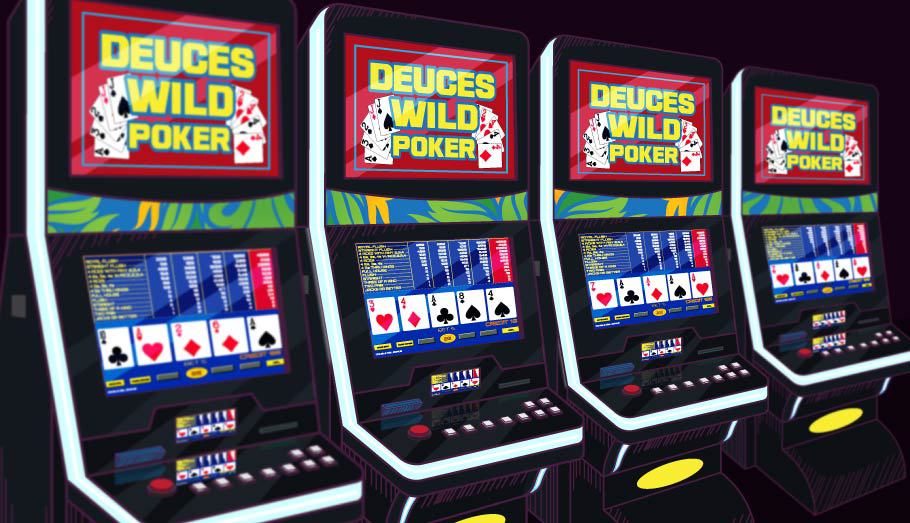Nearly every video poker pundit insists that players bet the maximum credits to activate what is called the royal flush bonus.
Most video poker pay tables pay 250-for-1 for a royal flush when one to four credits are bet. But they pay 800-for-1 when the maximum of five credits is bet.
This is a significant increase that gives the player an additional return of more than 1% overall. Is there a legitimate case for betting less than the maximum credits?
This article explores this question in more detail.
Contents
1. Why would anyone consider betting less than the maximum bet?
Most video poker experts would never consider betting less than the maximum. The return is simply too little.
What about the low rollers? The maximum bet is generally five times the single unit bet, for example, $1.25 rather then 25-cents for a quarter game, five dollars instead of one dollar for a dollar game.
If these amounts are too much for low-rollers, so the advice from most video poker experts is to choose a lower denomination game. These games almost always have lower – sometimes much lower – returns.
Is this really the best option?
2. Bet size and bankroll requirements
A general rule of thumb for long-term video poker bankroll requirements is three to four times the size of a royal flush. Generally, a royal flush pays 4,000-for-5.
- On a 25-cent game a royal flush pays $1,000 for a $1.25 bet.
- On a dollar game a royal flush pays $4,000 for a $5 bet.
A bankroll of three to four times a royal flush is:
- $3,000 to $4,000 for a 25-cent game
- $12,000 to $16,000 for a dollar game
Fortunately, long-term bankroll requirements are less important for infrequent, casual players. Having enough for the trip is important.
For more information on long-term, trip, and session bankroll requirements, please go here: Video Poker Bankroll Requirements (888casino.com).
Low rollers may not have enough to play max-credit 25-cent video poker for very long. Many casinos do have lower denominations such as nickel or penny games. These games tend to have lower returns, however. They can be from 2-5% lower.
Are the returns from lower denomination games worth the switch? Let’s take a look.

3. Returns: 25-cent one-credit versus five-credit
Here are the returns and variances of 9/6 (full-pay) and 8/5 jacks or better games.
- Jacks or better – 9/6
- Max-credit – 800-for-1 royal flush: return – 99.54%, house edge – 0.46%, variance – 19.51
- Single-credit – 250-for-1 royal flush: return – 98.37%, house edge – 1.63%, variance – 4.33
- Jacks or better – 8/5
- Max-credit – 800-for-1 royal flush: return 97.29%, house edge – 2.71%, variance – 19.32
- Single-credit – 250-for-1 royal flush: return – 96.06%, house edge – 3.94%, variance – 4.66
The return from single-credit is around 1.25% less than max-credit for both pay tables.
Variance is also considerably less. This is because there is no jackpot-sized winner when there is no royal flush bonus. It pays the same as any other straight flush.
Here are some examples.
Assume our casual, low roller video poker player spends four hours playing. Assume a slow rate of play – around 200 hands per hour. That is three-and-a-third hands per minute or one hand every 18 seconds.
At $1.25 per hand, 200 hands played amounts to $250 through the machine every hour – four hours = $1,000.
At 25-cents per hand, 200 hands played amounts to $50 through the machine every hour – four hours = $200.
To figure the average loss, multiply the dollars played by the house edge,
Jacks or better – 9/6
- Max-credit – $1,000 times 0.46% equals $4.60.
- Single-credit – $200 times 1.63% equals $3.26.
Jacks or better – 8/5
- Max-credit – $1,000 times 2.71% equals $27.10.
- Single-credit – $200 times 3.94% equals $7.88.
If you are lucky enough to find a full-pay 9/6 jacks or better game, the average loss is not that different playing $1.25 per hand versus 25-cents per hand – $4.60 versus $3.26.
On an 8/5 jacks or better game, the difference is dramatic – $27.10 versus $7.88.
It is also important to remember that the variance is considerably higher when playing max-credits. This means bankroll swings will be more dramatic.
Note: Returns and variances for other games and pay tables will vary somewhat.

4. Playing Strategy
Since the only difference when betting one credit versus five credits is the pay for a royal flush, hands favoring a royal flush will rank lower when playing less than max credits.
There are only a few changes in the strategy necessary to account for this.
For example, holding four cards of a royal flush outranks a flush hold and three cards of a royal flush outranks four cards of a flush playing max-credits in both 9/6 and 8/5 jacks or better. They are reversed when betting less than max-credits.
The lower returns of both nickel or penny video poker is caused by reduced pays on more than one other paying hand. This requires more changes in strategy to get the maximum possible return from the very low denomination games.
Also, many times the number of credits required for the royal flush bonus on nickel and penny games is 10 or more. This must be considered in the total bet and bankroll calculations.
5. Summary
The decision to play single-credit quarter video poker or very low denomination nickel and penny games is not simple. There is more to consider than just the bet size.
- Return for the one-credit game versus that of the nickel or penny game.
- Number of credits required to trigger the royal flush bonus.
- Variance of the game impacts bankroll requirements.
- Playing strategy – changes required for a one-credit versus max-credit bet are minimal. That may not be the case with nickel and penny games where multiple hands are affected.
Whether the low-roller plays single-credit quarter or max-credit lower denomination games, the return is reduced.
The bottom line: each video poker player must decide whether the reduced bet is worth the lower return. It is their money at risk. Is their enjoyment of the game worth the cost?
I cannot answer that question.


